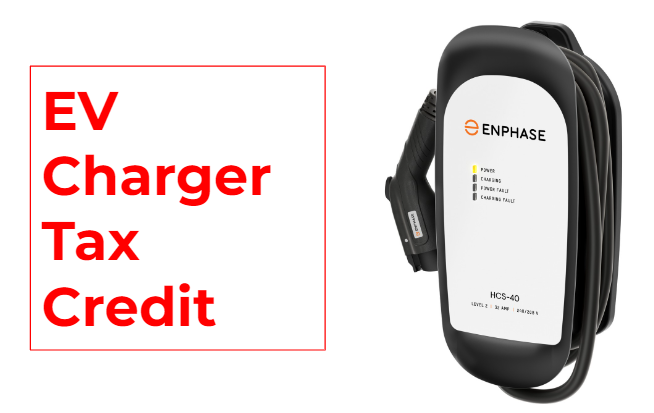Introduction
So it’s everyone’s favorite time of the year- tax season! There’s also more good news: you had an EV charger installed, and now it’s time to claim that tax credit. Before we get started, please see this standard disclaimer:
This guide is offered as basic instruction only and is not meant as professional tax preparation advice. For specific tax-related questions or issues, we recommend consulting a certified tax preparation specialist or CPA.
Great! In this article, we’ll specifically cover claiming the tax credit for an EV charger for personal use, not commercial. There is a commercial EV tax credit but that one is slightly more complicated, so let’s keep this one simple. The form is called Form 8911, Alternative Fuel Vehicle Refueling Property Credit. The most comprehensive and up-to-date information can be found here and the instructions here. As there are updates over time, we highly recommend you defer to them over this article.
Who Qualifies
Before we start crunching numbers, let’s start with a quick checklist to make sure you can actually claim the tax credit. See qualifications below:
- The charger was placed in service during that tax year.
- For example, if you’re doing your 2024 taxes, ensure the EV charger was placed in service in 2024.
- The original use of the property began with you.
- No used equipment qualifies!
- It must be on your main home.
- It must be in a Qualifying Location
- As described in a development from Jan 19, 2024: A qualifying location is a low-income community or any population census tract that is not an urban area. Great- what does that mean? Well. it means your address needs to fall in one of two census tracts. Let’s figure it out.
- Find your address on this map here. After you find your location, selecting the general area will give you an 11-digit code. Copy that code and find see if you can find it here. If you found it, you’re good! If you can’t find it , you have an additional step, as described below.
- This list may update periodically, so please check the instructions for Form 8911 for the most up-to-date information.
- This list is not exhaustive but will cover most residential cases. If you have any further questions, reach out to your tax professional!
If you don’t check even one of the bullets above, we’re sorry to say that you do not qualify. If you do, let’s keep going.
Line by Line
Ultimately, we are looking for a tax credit amount that will go on Line 6j on your 1040 Form. Credits are different than other tax-reducing tools and are not a refund, nor a deduction to reduce your adjusted gross income. This is a credit that you can apply to federal taxes you may owe. Let’s get started!
- Line 1: This will just be the total cost of the EV charger. This can be found on your contract. If you need an extra copy, please don’t hesitate to reach out.
- Line 2 – 9: If using this EV charger at your house for personal use, don’t worry about this section. Only fill out this section if you are claiming the credit as a business expense.
- Line 10: As we skipped Part 2, this number should just be the total price of your EV charger.
- For example: Let’s assume the EV charger and installation cost $2,400. So Line 1 and Line 10 will both read $2,400.
- Line 11: Take the amount in Line 10 and multiply by .3. This amount should be 30% of Line 10.
- Example: This number would be $700 if Line 10 is $2,400.
- Line 12: This number will be the number of EV Chargers, multiplied by $1,000.
- For 99% of us, this number will be 1 EV charger, multiplied by $1,000, so the number will be $1,000.
- Line 13: Enter the smaller number from Line 11 or 12.
- Line 14: This asks for your regular tax before credits. For individuals, enter the sum of the amounts from Form 1040, 1040-SR, or 1040-NR, line 16, and Schedule 2 (Form 1040), line 2.
- Consult your tax advisor if you need help with these, as it will vary based on your taxes!
- Line 15: This is for other tax credits that are applied before this one. As this is for personal use, this likely does not apply to you.
- Line 16: Subtract Line 15c from Line 14 to determine your net regular tax. If zero or less, enter zero and do not file. This will be quite rare so make sure all your figures are correct if you get zero or less.
- Line 17: This is used to determine your tentative minimum tax. For individuals, you will enter the amount from Form 6251, Line 9.
- Line 18: Subtract Line 17 from Line 16: If zero or less, don’t file unless you are claiming a credit on Line 9.
- Again, this will be relatively rare so double-check your numbers!
- Line 19: Last line! Enter the smaller of the two: Line 13 vs Line 18.
All done! The last step is to take that total from Line 19 and put it on Line 6j of Form 1040 – Schedule 3. We’ll plug two helpful sites here and here, as they really helped us in writing this article! We’ll also add an ending disclaimer; this guide covers some common ways to claim the tax credit, but everyone’s situation is unique. To ensure you’re following the most up-to-date regulations for your specific case, it’s important to consult with a tax professional. They can help you navigate the process and maximize your benefits.


